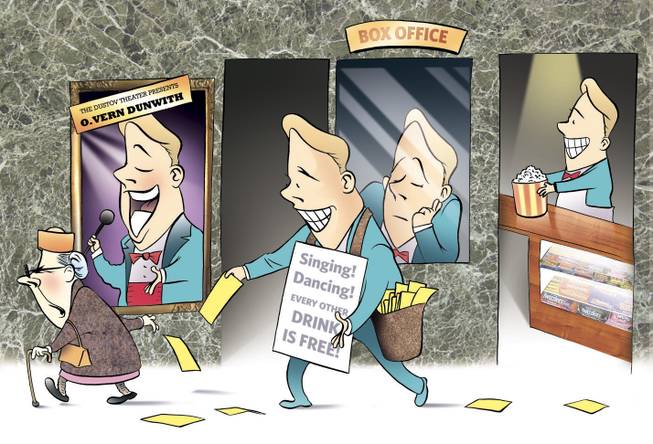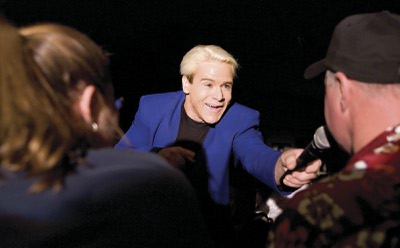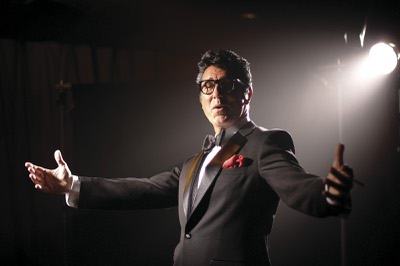Tuesday, Dec. 30, 2008 | 2 a.m.
Larry G. Jones steps onstage and for 70 minutes wows audiences with impressions of such performers as Tom Jones, perfected over the past 15 years.
The tiny, bare-bones showroom at the Royal Resort on Convention Center Drive is almost full, 50 fans in a room that holds about 60 — perhaps the smallest showroom in Las Vegas.
Down the street the real Tom Jones performs in the 750-seat Hollywood Theatre at the MGM Grand. It, too, is near capacity.
Tom Jones has little difficulty filling a room. But in this economy, Larry G. Jones is a struggling entertainer who spends more time promoting his act to ticket sellers than performing onstage for the dozens of tourists who find their way to his showroom.
This is a lousy time to be in show business in Vegas.
By the time he gets on stage, the hard part of Larry G. Jones’ day — hustling to sell tickets to his own show — is over.
“It’s real tough. I’m a guy people haven’t heard of, (performing) in a place they haven’t heard of,” said the 42-year-old native of Opelika, Ala.
And it’s a source of anxiety for Jones because, despite the chasm that exists between him and Tom Jones, they do have something in common. Neither was hired by the hotel where he’s appearing. Rather, each rents his showroom. It’s called four-walling.
In its purest form, four-walling involves the producer of a show — who could be the performer himself — assuming all the costs — and risks — of the production. It’s a practice that was unheard of in Vegas 30 years ago but that is prevalent today.
And it’s never been harder for the lesser-known performers, because of the recession, to fill their showrooms, even as their costs remain the same.
“It used to be that December would be a slow month. Well, it’s been slow since September. We’ve had a slow month for the past four or five months,” Jones said.
To sell tickets, he’s doing something that makes him uncomfortable: schmoozing with ticket brokers and concierges in hotels and shopping malls up and down the Strip. Maybe they’ll promote him a little bit harder if they can put his face to the name, he hopes.
“You’ve got to personally meet them, talk to them, get them to know you and invite them to your show,” he said. “These people have seen every huge, grand extravaganza in town, so when it comes to seeing a small show like mine, they say, ‘Yeah, we’ll try to come by.’ But most don’t.
“I hate hustling. I’m not comfortable trying to sell myself, but I have no choice. I don’t have a day job or any other skills. So these days I’m really having to hustle.”
It’s an uphill struggle.
Terry Jenkins, corporate director of entertainment for Boyd Gaming, names the big pitfall of four-walling: You’ve got to spend money like there’s no recession.
“You’ve got to have marquee value or it’s just not going to work for you. You can’t be undercapitalized. It will cost you hundreds of thousands of dollars to educate people from the Midwest as to who you are. They come to town on a three- or four-day vacation and they know Celine Dion and Bette Midler and Wayne Newton. They know Donny and Marie. But they don’t know ‘Point Break’ and they don’t know ‘Ice.’
“You’ve got to have a good half a million in the bank just to get your name out there. A billboard with a good location can cost from $11,000 to $15,000 a month.”
And Frank Lieberman, a veteran Vegas publicist, warns that because tourists have grown stingy in this economy, most are carefully planning their trips weeks or months in advance — and making reservations for shows that they’ve heard of back home.
They probably haven’t heard of the likes of Larry G. Jones. It’s a dilemma he and other less-recognizable entertainers face as they try to succeed in Las Vegas, one of the most competitive entertainment markets in the world. “And the lowering of ticket prices of the big shows is going to impact the smaller shows,” Lieberman said.
As a result, by the time tourists land, “they’ve already decided what shows to see,” Lieberman said. And because an increasing number of visitors are seeing only one show, it’s possible, then, that all of Larry G. Jones’ hustling will be for naught.
David Saxe has seen plenty of four-wall shows come and go.
Saxe owns the V Theater showroom at the Miracle Mile shopping mall adjacent to the Planet Hollywood hotel, where he stages two of his own shows — a variety show and a Beatles tribute show — and rents the space to producers of four other shows. There’s the female magician, the game show, the comedy pet show, the hypnosis show.
He said he averages 10 calls a week from people with shows they are sure will succeed, but his room is full for now.
But that could change any day. That’s the nature of four-walling: At some point, the struggling performer simply can’t afford to pay the rent.
The classic case of a failure is “Point Break Live,” which leased space at the V Theater this summer. The show, a stage version of the movie, lasted less than a week.
“I didn’t think it had a chance,” Saxe said. “But nobody puts a gun to their head. I tell them that they’ve got to be fully funded, that they’re going to lose everything and more. But performers have immense egos. So, for ‘Point Break Live,’ I put on my landlord hat. The space was available.
“I gave them the full disclaimer. They said ‘We know, we know, but we’re going to sell out.’ And they closed the show four days later.”
Saxe knows how difficult it is to sell tickets, and has become as imaginative as any in selling them. Years ago, he increased the price of tickets — and allowed ticket brokers to keep a larger commission, just so they’d push his shows before the others. It generally drove up prices across town.
Then, he began discounting tickets, offering two for one to locals. Others followed suit.
More recently, Saxe has found a new way to sell tickets: discounted, on eBay.
Impressionist Tom Stevens, who performs in a 140-seat showroom at the Riviera, likes the schmoozing approach, but has taken a new tack with ticket sellers.
He refuses to hire promoters to hustle for him — at $3,000 to $4,000 or more a month.
“My wife and I have been bringing chocolate chip cookies to the ticket brokers. She baked 700 of them. Then we visited the brokers, wished them a merry Christmas, and left them with a bunch of cookies.
“That’s being business-savvy,” he said. “This town is built on relationships. Cookies help. I think it will pay off this coming year.”
Producer Dick Feeney isn’t as optimistic about what the new year will bring.
“January and February will be the cruncher for a lot of people,” said Feeney, who over 20 years has produced such shows as “Viva Las Vegas,” “Showgirls,” “The Great Gleason,” “Bottoms Up,” “Forbidden Vegas,” and “Playboy’s Girls of Rock & Roll.”
“There are people out there who are pouring a lot of money into a hole and will surrender sooner or later. It’s getting harder and harder for the shows to make it,” Feeney said.
It’s so bad, show producer Adam Steck said, he won’t even try to relaunch his “American Storm,” which recently closed for reasons that he said were unrelated to the economy.
“I’m definitely not opening anything new anytime soon,” Steck said. “It’s time to batten down the hatches and just hang in there.”
If anyone in town has a stake in the success of four-wallers, it might be Art Courey. He leases the showroom at the Royal Resort so he can operate its bar, a business he knows.
When he took control of the bar a year ago, he struggled to bring in customers. There was little to sell the place.
That’s when magician Dixie Dooley proposed to Courey that he make the small showroom available to performers. They could bring in customers.
Courey liked the idea, and came up with a simple business agreement: Offer performers free use of the showroom. They’d keep the ticket revenue for themselves. The money Courey wanted was from selling drinks.
Dooley and three other performers agreed: magician David Darkstone, comic Joe Lowers and Larry G. Jones, the Tom Jones impressionist. (Each of the three pays Dooley a fee to use his curtains and lights.)
“To their credit, each has done a pretty good job considering the current economy,” Courey said, adding that Dooley drew a capacity crowd last weekend.
But the other magic show struggles to bring in a couple of dozen people, he said.
“This year is the hardest I’ve ever worked in my business,” Courey said. “I’m happy to see ’08 go. It’s been extremely difficult.”
Editor's note: This story has been altered to correct an mischaracterization in the original version that stated Larry G. Jones does impressions only of Tom Jones. Jones is an impressionist who performs many characters, including Tom Jones.




Join the Discussion:
Check this out for a full explanation of our conversion to the LiveFyre commenting system and instructions on how to sign up for an account.
Full comments policy